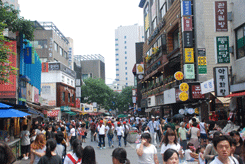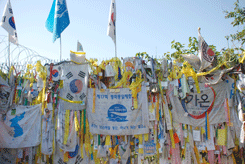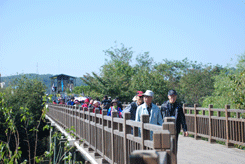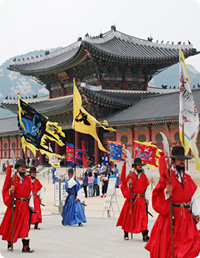STOPOVER
Overnight - The 3rd Tunnel



Tour Highlights
- Mangbaedan Altar
- Freedom Bridge
- Locomotive Engine
- Peace Stones
- Peace Bell
- The 3rd Tunnel
- Dora Observatory
Touching down at Incheon International Airport places you in the heart of Korea. After you clear Passport and Customs control, your tour guide will greet you at the main passenger terminal and transport you to your hotel.
Day 2 Seoul - DMZ - Departure (B) 170km
Please note that the DMZ is a politically sensitive area, and is therefore not always open to tourists.
In the event that the area cannot be visited, alternate sightseeing will be arranged.
The 3rd Tunnel tour
Rules and Regulations |
 Your touring today will be private today until you reach Imjingak, at which time you will board a bus with other tourists as private tours of the tunnel and DMZ area are not allowed. Your private tour guide will remain with you throughout the day.
On the way you will drive the highway that is lined on one side with barbed wire and frequent guard stations spaced along the river that makes up part of the border. Imjingak is the furthest north point in the area than you can go freely, and a park with an array of monuments and statues that speak to the Korean War (1950-1953).
Your touring today will be private today until you reach Imjingak, at which time you will board a bus with other tourists as private tours of the tunnel and DMZ area are not allowed. Your private tour guide will remain with you throughout the day.
On the way you will drive the highway that is lined on one side with barbed wire and frequent guard stations spaced along the river that makes up part of the border. Imjingak is the furthest north point in the area than you can go freely, and a park with an array of monuments and statues that speak to the Korean War (1950-1953).
One such monument is Mangbaedan, a memorial site where displaced North Koreans pray for their ancestors. Near Mangbaedan is the Freedom Bridge, and was an important site where 12,773 prisoners of war returned to freedom. This short, sturdy wooden structure ends at a barricade, which embodies the North. The altar and the bridge now serve as places of remembrance for displaced families, and the millions of bright colored ribbons tied to the fence have messages of hope, dreams and wishes for unification between South and North Korea.
You can also see a derelict locomotive engine shot full of bullet holes and its bent wheels - not particularly special in any way other than it shows the destruction of war. Having been left in the DMZ since bombs derailed it during the Korean War; it was cleaned up and moved here in 2009. There is a collection of stones from 86 battlefields in 64 countries known as the Peace Stones that have witnessed suffering and grief of war.
Then, you board a bus to continue with other tourists on to the Demilitarized Zone which straddles the South and North Korean border. A 4km wide buffer of land stretches the breadth of the Korean peninsula. Total 1,292 signboards of the Military Demarcation Line were established and 696 of which are controlled by the U.N. Forces while 596 are under the control of North Korea and China. Although an Armistice came into effect in July 1953, the two Koreas are still technically in an active state of war. Tensions between the two countries remain high, and the border is patrolled by thousands of troops on both sides.
Before being allowed to enter the DMZ, you will have to obtain passport and security clearance at the Unification Bridge, the first control line with sentries and photo opportunities will be limited.
The 3rd tunnel is one of the four infiltration tunnels dug by the North to facilitate an invasion of the South. Discovered on October 17, 1978, it is a 1,635m long, 2m high and 2m wide, and could have accommodated 30,000 soldiers per hour in what was apparently designed for a surprise attack on Seoul. The tunnel runs through bedrock at a depth of about 73m below ground; 435m of which are found in the South over the Military Demarcation Line (MDL). It is designed at a three thousandth angle with northern side lower than southern side, so that water does not stagnate inside tunnel. After ducking and crouching your way 265m through the tunnel, you will reach one of the cement walls with iron door near the MDL that will prevent you from going any further north and where you peep through a small window at a barricade, just to see another barricade in the distance. You can clearly see the drill marks for dynamite all pointing toward the South. This finding, along with other clues, clearly affirmed their construction.
DMZ Exhibition Hall features model of soldiers digging the tunnel, equipment used by the North, model of Panmunjeom (Joint Security Area), a timeline of major North Korean provocations over the South since 1950, and photographs of the historical events about Korea's division. And time for a short video including old film that takes you back in time to the signing of the armistice and the creation of the DMZ.
Next stop is Dora Observatory. As you approach, you will see an eye catching slogan printed up on the wall "End of separation, beginning of unification". The observatory looks across the land north of Demilitarized Zone, the road and train track stretched side by side ahead into the North Korea,
bare mountains, treeless hills, watchtower, North Korean propaganda village and Gaeseong Industrial Complex.
After a full day tour of DMZ realizing stark reality, you are transferred back to the airport in time for your flight.






